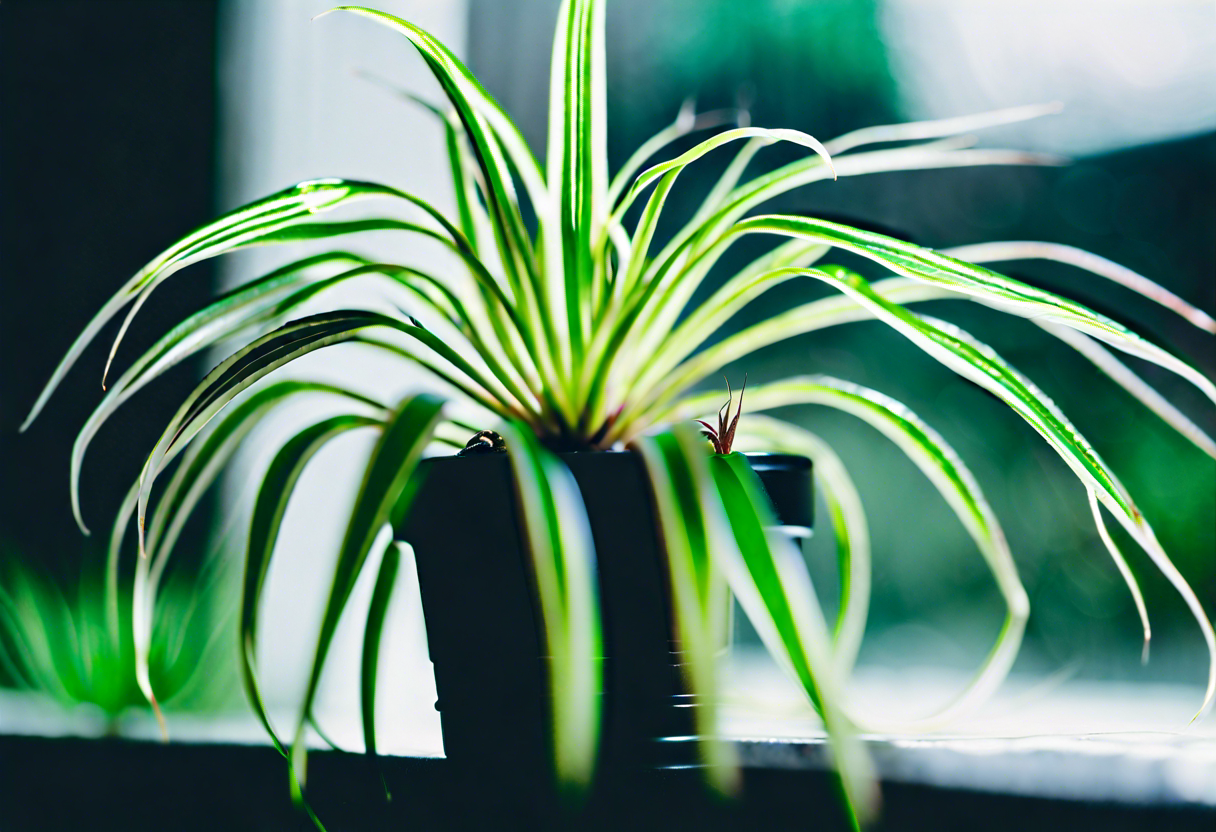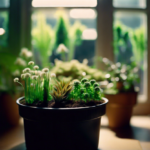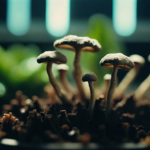Spider Plant (Chlorophytum comosum) – An Overview
Choosing the Right Location for Your Spider Plant
When it comes to caring for your Spider Plant (Chlorophytum comosum), one of the most important factors to consider is selecting the right location for your plant. The placement of your Spider Plant can greatly impact its overall health and growth. In this guide, we will explore the best practices for choosing the ideal spot for your Spider Plant to thrive.
First and foremost, it is important to consider the lighting conditions for your Spider Plant. This plant prefers bright, indirect light, making it an excellent choice for indoor settings. Avoid placing your Spider Plant in direct sunlight, as this can lead to sunburn and damage the leaves. Instead, opt for a location near a window with filtered or partial sunlight. If your Spider Plant is placed too far away from a light source, it may exhibit slower growth and its leaves may lose their vibrant green color.
Temperature is another important consideration for the health of your Spider Plant. Ideally, keep the plant in a room with temperatures ranging from 60 to 85°F (15 to 29°C). Spider Plants are resilient and can tolerate a wide range of temperatures, but extreme cold or heat can negatively affect their growth. Avoid placing your Spider Plant near drafty windows or close to heating or cooling vents, as sudden temperature fluctuations can stress the plant.
Humidity levels also play a role in Spider Plant care. These plants prefer moderate to high humidity, making them well-suited for bathrooms or kitchens where humidity tends to be naturally higher. If the air in your home is particularly dry, consider using a humidifier or placing a tray of water near your Spider Plant to increase humidity. Avoid positioning your Spider Plant in areas with low humidity, such as near air conditioning units or heating systems, as this can cause the plant’s leaves to become dry and crispy.
In addition to lighting, temperature, and humidity, it is important to choose a location that provides adequate airflow. Good air circulation helps prevent the build-up of stagnant air and can reduce the risk of pests or diseases. Avoid overcrowding your Spider Plant by placing it too close to other plants or objects that may obstruct airflow. This will ensure that your plant receives fresh air and stays healthy.
Selecting the right location for your Spider Plant is crucial for its overall well-being. Remember to provide bright, indirect light, maintain moderate temperatures, ensure moderate to high humidity levels, and provide adequate airflow. By following these guidelines, you can create the perfect environment for your Spider Plant to thrive and enjoy its graceful cascading leaves.
Watering and Moisture Requirements for Spider Plants
Proper watering and moisture management are crucial for the health and well-being of your Spider Plant (Chlorophytum comosum). This popular indoor plant is known for its hardiness and ability to thrive in a variety of conditions, but it still requires regular and consistent watering to flourish.
Spider Plants prefer well-draining soil, so it’s important to choose a pot with drainage holes to prevent waterlogged roots. Overwatering can lead to root rot and other fungal diseases, so it’s essential to strike the right balance.
The frequency of watering depends on a few factors, such as the size of the pot, the temperature, humidity levels, and the season. As a general rule, Spider Plants should be watered thoroughly whenever the top inch of soil feels dry to the touch. This typically translates to around once a week during the growing season and less frequently in the winter months when the plant is in a dormant phase.
When watering your Spider Plant, make sure to saturate the soil evenly. Allow the excess water to drain out through the bottom of the pot, ensuring that it doesn’t sit in a saucer or tray. Avoid using water that contains high levels of dissolved minerals, as Spider Plants are sensitive to salt buildup. Consider using filtered water or allowing tap water to sit overnight before using it on your plant.
In addition to regular watering, Spider Plants benefit from moderate humidity levels. They can tolerate dry indoor air but thrive when provided with some moisture. You can increase humidity by misting the foliage with water, placing the plant on a tray filled with water and pebbles, or using a humidifier in the room. However, be cautious of over-misting, as excessive moisture on the leaves can promote the growth of fungal diseases.
Keep an eye on your Spider Plant for signs of underwatering or overwatering. Yellowing leaves may indicate overwatering, while brown, crispy leaves can be a sign of underwatering. Adjust your watering routine accordingly and consider the environmental conditions your plant is exposed to.
By following these watering and moisture guidelines, you can ensure that your Spider Plant remains healthy, vibrant, and a beautiful addition to your indoor space.
Spider Plant Propagation Techniques
Spider plants (Chlorophytum comosum) are popular houseplants known for their graceful arching leaves and cascading foliage. They are not only aesthetically pleasing but also easy to propagate, making them a favorite among plant enthusiasts. In this guide, we will explore different spider plant propagation techniques that you can try to expand your collection or share the joy of these beautiful plants with friends and family.
One of the most common ways to propagate spider plants is through division. As spider plants grow, they develop thick, fleshy rhizomes underground. These rhizomes eventually give rise to new shoots, which can be separated from the parent plant to create new individuals. To propagate through division, start by gently removing the spider plant from its pot, being careful not to damage the roots. Look for sections of the plant that have their own roots and shoots. Use a clean, sharp knife or scissors to separate these sections from the parent plant. Once separated, plant each section in a separate pot filled with well-draining potting mix. Keep the soil moist and place the new plants in a warm, bright location, away from direct sunlight.
Another popular method of spider plant propagation is through plantlets. Spider plants produce tiny offshoots, often referred to as plantlets or spiderettes, which grow from the main plant’s long, arching stems. These plantlets can be rooted while still attached to the parent plant or detached and grown separately. To propagate through plantlets, wait until they have developed a few roots, typically about 2 inches in length. Once the roots are established, you can detach the plantlet from the parent plant and plant it in its own pot with well-draining soil. Water the newly potted plantlet thoroughly and provide it with bright, indirect light.
Spider plants can also be propagated through stem cuttings. This method involves taking a healthy stem and placing it in a suitable rooting medium. Select a stem that is free from any signs of disease or damage. Using a clean, sharp knife or scissors, cut a section of the stem that is around 4-6 inches long. Remove any leaves from the lower half of the cutting and dip the cut end in rooting hormone, which can help encourage root development. Plant the cutting in a pot filled with moist, well-draining soil or perlite. Cover the pot with a plastic bag or place it inside a propagator to create a humid environment. Keep the soil moist and provide the cutting with bright, indirect light. Within a few weeks, roots should start to form, indicating successful propagation.
Spider plant propagation is a rewarding and enjoyable process. Whether you choose to divide the plant, propagate through plantlets, or take stem cuttings, you will find that spider plants are relatively easy to propagate and can quickly multiply your collection. Experiment with different techniques to find the one that works best for you and soon you’ll have a house full of these charming, resilient plants.
Common Pests and Diseases Affecting Spider Plants
Spider plants, scientifically known as Chlorophytum comosum, are popular houseplants known for their striking foliage and air-purifying abilities. While spider plants are generally hardy and low-maintenance, they can still be susceptible to certain pests and diseases. In this guide, we will explore the common pests and diseases that can affect spider plants and provide tips on how to prevent and treat them.
Pests
-
Spider Mites – Spider mites are tiny pests that can infest spider plants and cause damage by sucking sap from the leaves, leading to yellowing, wilting, and webbing. To prevent spider mite infestations, regularly inspect your plants for any signs of webbing or small dots on the leaves. If an infestation is detected, isolate the affected plant and gently wipe the leaves with a mild soapy water solution. You can also use insecticidal soap or neem oil spray to control spider mites.
-
Mealybugs – Mealybugs are soft-bodied insects that feed on plant sap and often appear as white cottony masses on the leaves and stems of spider plants. To get rid of mealybugs, manually remove them by using a cotton swab dipped in rubbing alcohol or by spraying the affected areas with a solution of water and dish soap. Regularly inspect your plants and isolate any infested plants to prevent the spread of mealybugs.
-
Fungus Gnats – Fungus gnats are small flies that lay their eggs in moist soil. The larvae feed on organic matter and plant roots, potentially causing damage to the roots of spider plants. To control fungus gnats, ensure proper drainage in your plant’s pots and avoid overwatering. You can also use sticky traps or insecticidal soap to catch adult gnats and prevent them from laying eggs.
Diseases
-
Root Rot – Root rot is a common disease that affects spider plants when their roots are constantly sitting in waterlogged soil. This can lead to yellowing leaves, wilting, and eventually death if not addressed. To prevent root rot, ensure proper drainage by using well-draining soil and allowing the top inch of soil to dry out before watering again. If root rot occurs, remove the affected plant from its pot, trim off any rotting roots, and repot in fresh, dry soil.
-
Leaf Spot Diseases – Leaf spot diseases, such as bacterial leaf spot and fungal leaf spot, can cause dark spots or lesions on the leaves of spider plants. To prevent leaf spot diseases, avoid overhead watering and provide good air circulation around the plants. If leaf spot occurs, prune off the affected leaves and avoid wetting the foliage when watering.
By following these preventive measures and promptly addressing any pest or disease issues, you can keep your spider plant healthy and thriving. Regularly inspecting your plants, providing optimal growing conditions, and practicing good hygiene can go a long way in maintaining the overall health of your spider plants.
Conclusion
Spider Plants (Chlorophytum comosum) are a popular choice for indoor gardening enthusiasts due to their easy care requirements and striking appearance. With their cascading green foliage and delicate white flowers, these plants can add a touch of natural beauty to any indoor space.
When it comes to choosing the right location for your Spider Plant, it’s important to consider its light requirements. These plants prefer bright, indirect light, making them perfect for placement near a north or east-facing window. However, they can also tolerate lower light conditions, making them adaptable to various indoor environments.
Proper watering and moisture requirements are essential for the health and vitality of Spider Plants. While they prefer evenly moist soil, it’s important not to overwater them, as this can lead to root rot. On the other hand, allowing the soil to dry out completely can cause the leaves to wilt and lose their vibrant green color. Finding the right balance and watering the plant when the top inch of soil feels dry is key to promoting healthy growth.
Spider Plants are known for their prolific propagation abilities, making it easy to expand your collection or share them with friends. There are several methods you can use to propagate Spider Plants, including division, plantlets, and stem cuttings. Each technique offers its own advantages, allowing you to choose the one that best suits your preferences and resources.
Like any plant, Spider Plants are susceptible to certain pests and diseases. Common pests that may affect these plants include spider mites, aphids, and mealybugs. Regular inspections and prompt treatment with organic insecticides or natural remedies can help keep these pests at bay. Furthermore, practicing good hygiene, such as removing dead leaves and debris, can prevent the spread of diseases and ensure the plant’s overall health.
The Spider Plant (Chlorophytum comosum) is a versatile and low-maintenance houseplant that can thrive in a variety of indoor environments. By understanding their light requirements, watering needs, propagation techniques, and how to combat common pests and diseases, you can ensure that your Spider Plant remains healthy and vibrant for years to come. So, go ahead and bring the natural charm of Spider Plants into your home and enjoy the many benefits they have to offer.


